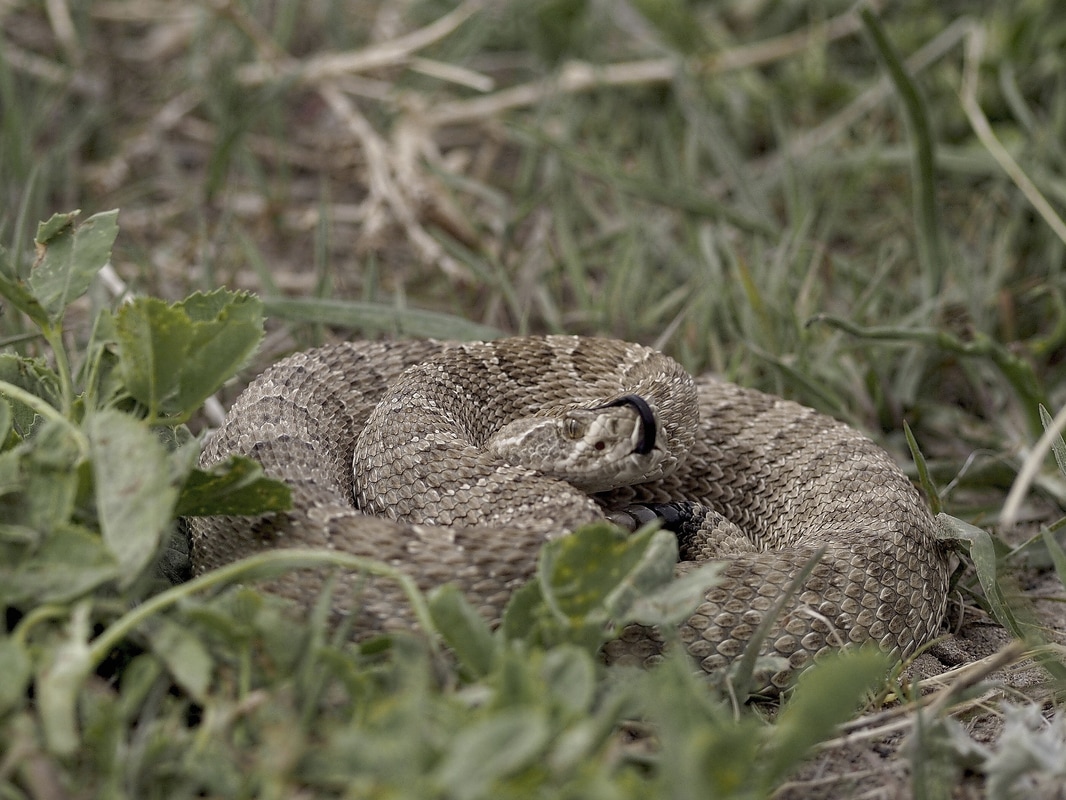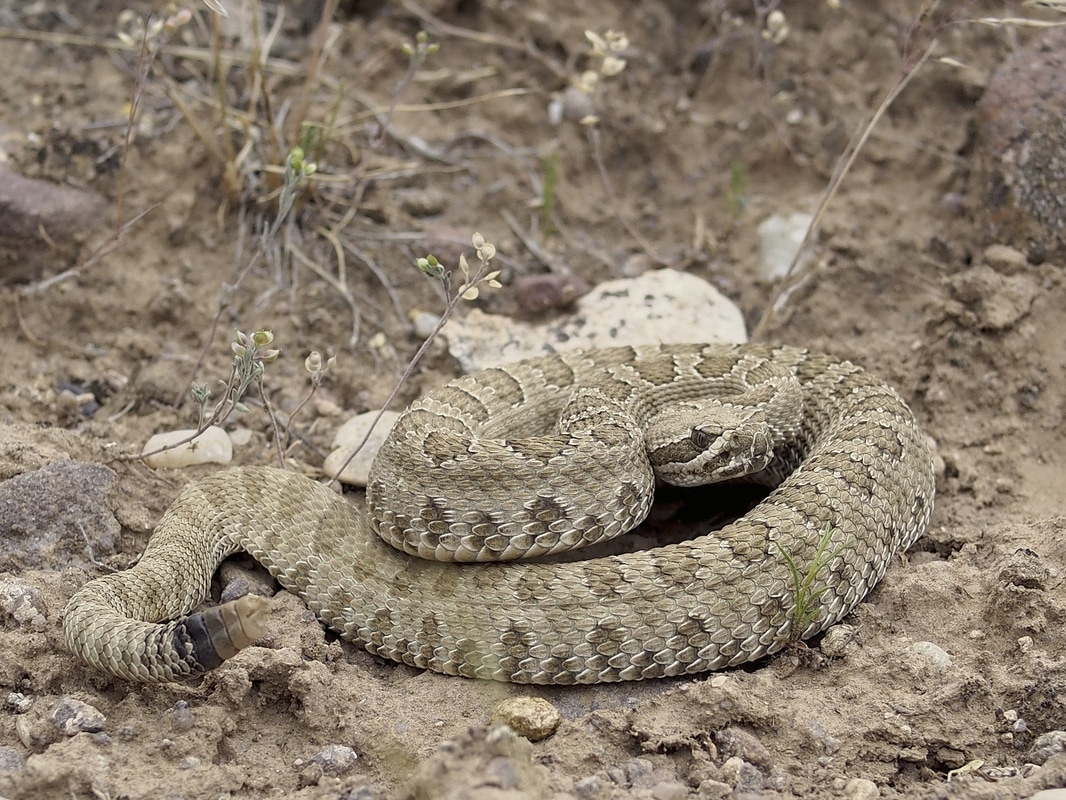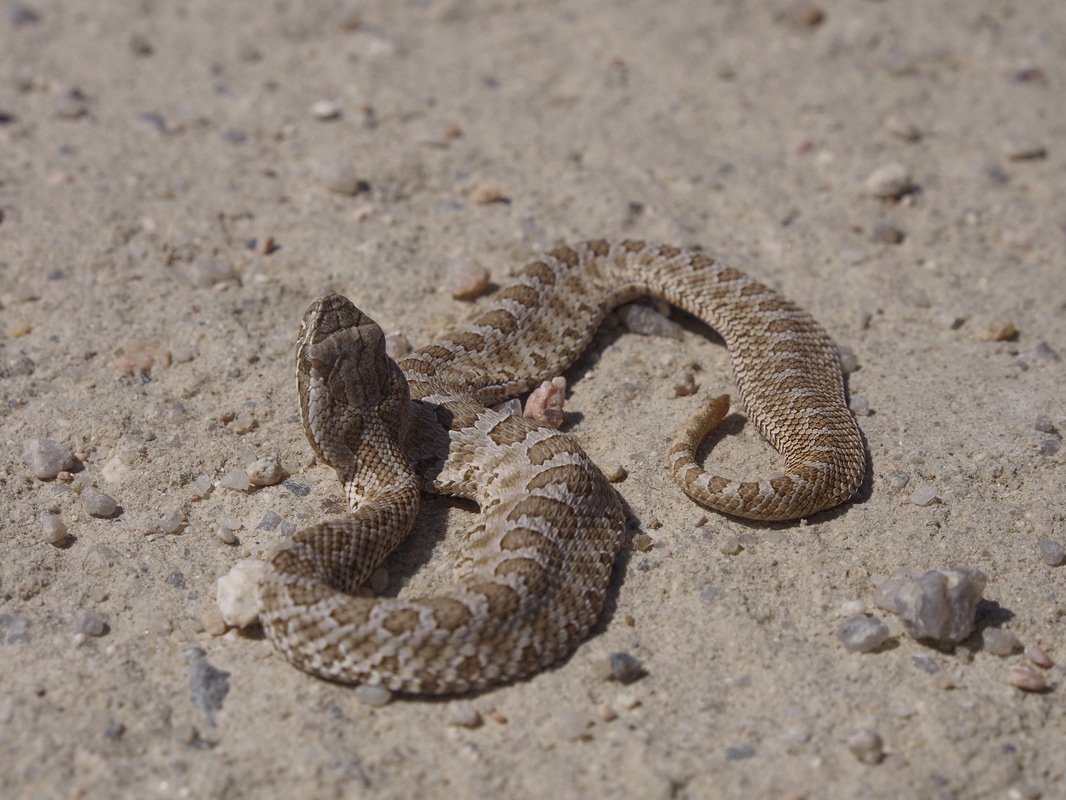It’s snowing again in the Front Range, meaning our prairie rattlesnakes are taking shelter below the surface. In the past few posts we’ve learned a little bit about Adaptation Environmental Services and Jefferson County Open Space as well as the background of this tracking project. It seems fitting now to give a quick biography about the animal all of the buzz is about: the prairie rattlesnake.
It might be said that the prairie rattlesnake was ‘born’ (to the scientific community, at least) in 1818, when Constantine Samuel Rafinesque-Schmaltz (hereafter just ‘Rafinesque’) wrote the first known description of the animal. While we know this snake by the name ‘prairie rattlesnake,’ it is something of a nickname, while its proper full name (at least as far as scientists are concerned) is written in Latin as Crotalus viridis. Confusingly, our rattlesnake’s first and last name are swapped from the usual position, as its individual name viridis (‘green’) comes after the name shared by its close relatives, Crotalus (‘rattle’). When Rafinesque gave the prairie rattlesnake the name viridis, he was likely referring to the color of the prairie rattlesnake’s scales, which often have a greenish tint.
The prairie rattlesnake’s 31 closest relatives all share its last name, Crotalus, and while each is unique in its own way, they all have a lot in common. They are all called rattlesnakes, and each has a rattle at the end of their tail made of keratin, the same substance that makes up human hair and fingernails. On either side of the face, each has a deep pit between the nostril and vertically slit, lidless eye that gives them with the extraordinary ability to ‘see’ even the tiniest temperature variations. All possess two large, hollow teeth called fangs that fold like pocket knives into the roof of their mouth when not in use. The fangs extend to deliver a toxic chemical weapon responsible for their collective infamy, venom, into the bodies of their food and their many enemies.
The only other snake that bears the name Crotalus in Colorado is the midget faded rattlesnake (Crotalus oreganus), which lives on the western side of the Rocky Mountains. A more distant cousin, the desert massasauga (Sistrurus catenatus), is a tiny rattlesnake armored with a helmet of large scales on its head that lives in southeastern Colorado. No other dangerously venomous snakes live in the state. In the Front Range of Colorado, including in Jefferson County, the prairie rattlesnake has no relatives that live in town.
The prairie rattlesnake is fairly big for a rattlesnake, at its largest reaching up to 65 inches from nose to the tip of the rattle, though in Colorado our rattlesnake averages only about 28 inches. With regards to its wardrobe, its coat of keeled scales may be greenish gray, olive green, greenish brown, light brown, yellowish, or even pink. A handsome pattern of dark, oval blotches with light borders run down the snake’s back and turn into dark bands near the tail, while a white line is painted on either side of each eye.
This rattlesnake enjoys the Great Plains has been found just about everywhere within the region and few places outside it. It isn’t picky about its living situation provided that it has a den for escaping below the frost line during cold snaps and the local grocery is full of tasty rats. Given its unfussy lifestyle, the prairie rattlesnake lives in just about any land area in Colorado below 9,500 feet (give them a break, its cold up there!), including prairies (who would’ve guessed?), dry basins, and wooded mountains.
In its career, the prairie rattlesnake is something of a professional hunter whose implement of choice is its moderately toxic (for a rattlesnake) venom. In its youth, the young rattlesnake hones its skills pursuing small game including lizards, frogs, toads, insects and birds before maturing and moving on to its true calling - rodents. The adult prairie rattlesnake is an efficient ambush killer of rats, mice, gophers, young prairie dogs and other small furry critters. Despite its considerable hunting skills, the prairie rattlesnake is never too proud to turn down a free meal and happily downs eggs and even carrion.
Prairie rattlesnakes have been around a long time, and its tough to imagine a long career that didn’t include the making of a few enemies. Golden Eagles, harriers, and other raptors are skilled hunters in their own right that may try to turn our rattlesnake into dinner. However, it is without a doubt that the most prevalent killers of the prairie rattlesnake are humans.
Once the snow clears we will be back out across North Table Mountain collecting information on the movements of our eleven transmittered snakes and keep you apprised of what they’re up to. We’ll also be trying to capture an additional nine snakes to fill our quota of 20. If you see us out in the field, stop by and say hello!
It might be said that the prairie rattlesnake was ‘born’ (to the scientific community, at least) in 1818, when Constantine Samuel Rafinesque-Schmaltz (hereafter just ‘Rafinesque’) wrote the first known description of the animal. While we know this snake by the name ‘prairie rattlesnake,’ it is something of a nickname, while its proper full name (at least as far as scientists are concerned) is written in Latin as Crotalus viridis. Confusingly, our rattlesnake’s first and last name are swapped from the usual position, as its individual name viridis (‘green’) comes after the name shared by its close relatives, Crotalus (‘rattle’). When Rafinesque gave the prairie rattlesnake the name viridis, he was likely referring to the color of the prairie rattlesnake’s scales, which often have a greenish tint.
The prairie rattlesnake’s 31 closest relatives all share its last name, Crotalus, and while each is unique in its own way, they all have a lot in common. They are all called rattlesnakes, and each has a rattle at the end of their tail made of keratin, the same substance that makes up human hair and fingernails. On either side of the face, each has a deep pit between the nostril and vertically slit, lidless eye that gives them with the extraordinary ability to ‘see’ even the tiniest temperature variations. All possess two large, hollow teeth called fangs that fold like pocket knives into the roof of their mouth when not in use. The fangs extend to deliver a toxic chemical weapon responsible for their collective infamy, venom, into the bodies of their food and their many enemies.
The only other snake that bears the name Crotalus in Colorado is the midget faded rattlesnake (Crotalus oreganus), which lives on the western side of the Rocky Mountains. A more distant cousin, the desert massasauga (Sistrurus catenatus), is a tiny rattlesnake armored with a helmet of large scales on its head that lives in southeastern Colorado. No other dangerously venomous snakes live in the state. In the Front Range of Colorado, including in Jefferson County, the prairie rattlesnake has no relatives that live in town.
The prairie rattlesnake is fairly big for a rattlesnake, at its largest reaching up to 65 inches from nose to the tip of the rattle, though in Colorado our rattlesnake averages only about 28 inches. With regards to its wardrobe, its coat of keeled scales may be greenish gray, olive green, greenish brown, light brown, yellowish, or even pink. A handsome pattern of dark, oval blotches with light borders run down the snake’s back and turn into dark bands near the tail, while a white line is painted on either side of each eye.
This rattlesnake enjoys the Great Plains has been found just about everywhere within the region and few places outside it. It isn’t picky about its living situation provided that it has a den for escaping below the frost line during cold snaps and the local grocery is full of tasty rats. Given its unfussy lifestyle, the prairie rattlesnake lives in just about any land area in Colorado below 9,500 feet (give them a break, its cold up there!), including prairies (who would’ve guessed?), dry basins, and wooded mountains.
In its career, the prairie rattlesnake is something of a professional hunter whose implement of choice is its moderately toxic (for a rattlesnake) venom. In its youth, the young rattlesnake hones its skills pursuing small game including lizards, frogs, toads, insects and birds before maturing and moving on to its true calling - rodents. The adult prairie rattlesnake is an efficient ambush killer of rats, mice, gophers, young prairie dogs and other small furry critters. Despite its considerable hunting skills, the prairie rattlesnake is never too proud to turn down a free meal and happily downs eggs and even carrion.
Prairie rattlesnakes have been around a long time, and its tough to imagine a long career that didn’t include the making of a few enemies. Golden Eagles, harriers, and other raptors are skilled hunters in their own right that may try to turn our rattlesnake into dinner. However, it is without a doubt that the most prevalent killers of the prairie rattlesnake are humans.
Once the snow clears we will be back out across North Table Mountain collecting information on the movements of our eleven transmittered snakes and keep you apprised of what they’re up to. We’ll also be trying to capture an additional nine snakes to fill our quota of 20. If you see us out in the field, stop by and say hello!






 RSS Feed
RSS Feed
